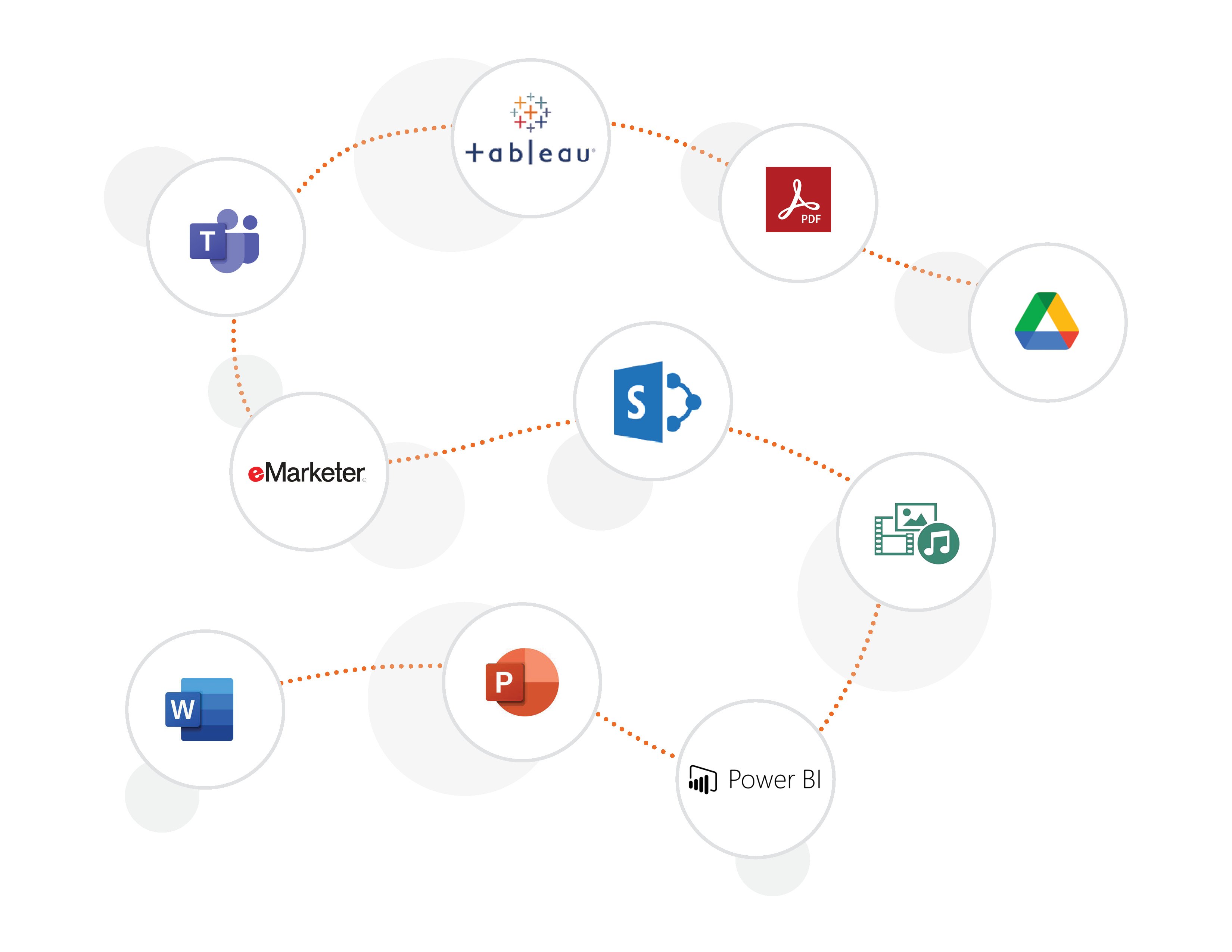What is Knowledge Management?
The definition of Knowledge Management is the efficient handling of information and resources within a commercial organization.
When you ask most companies how well they handle knowledge management, the answer you will most likely hear is “terribly.” With the abundance of data at our fingertips and the seemingly endless ability to store multitudes of data on servers or in the cloud, companies are faced with more data than most can handle efficiently and effectively. Although not always articulated, knowledge loss and lost data have been plaguing workforces for decades.

Table of Contents
95% of accumulated data goes unused. Permanently put on proverbial shelves and forgotten.
Common Knowledge Management Pain Points
Employee Turnover or Transitions
Every time employees leave a position, they are taking their institutional knowledge with them.
Redundant Research
Redundant research is the source of millions of wanted dollars. Often companies do the same research over and over because of a lack of awareness that it has already been done or the inability to find old insights that have already been developed.
Organization Disruption
During situations like mergers and acquisitions, the amount of knowledge that must be acquired cross-company is vast. The time that it takes to realize the benefits of a merger can be significantly extended if a knowledge-sharing strategy has not been considered.
Survey Data
Surveys are a powerful tool in acquiring insights and information. Often, these insights are never brought into a company’s internal systems. Instead, these data points are left in the survey tool, often never to be accessed or remembered again.
Tool Overload
There is a multitude of accessible and affordable tools different corporate departments implement to help them succeed in their roles. These tools contain rich data and insights but are typically only accessible by the users that know how to (and have the credentials) access the information. This data is available only to a select few instead of to benefit the greater good of the company.
Individual Hard Drives
Valuable corporate work often gets saved and hidden from others in the company when individual hard drives are used to store data. Without Knowledge Management protocols and systems in place, this is a common challenge companies face.
Dependence on Subject Matter Experts
SMEs lose valuable time fielding repetitive questions and requests that should be easily answered from information already documented.
What is a Knowledge
Management System
While knowledge management has been around for decades, the importance of having a user-friendly knowledge management system drove innovation for a variety of digital platforms. However, many of those systems still have their shortcomings, especially with the need to access unstructured data across multiple platforms.
Organizations have vast repositories of data, millions of pages of PowerPoint presentations, PDFs, Word documents, and more. We have seen that as much as 95% of organizational data is never accessed again after 90 days from creation. Teams in every industry are faced with the issue of holding a bounty of information without an effective way to search the unstructured data or knowledge assets owned by the company.
Large companies, in particular, are no longer simply interested in improving the process of managing data, they are racing to implement AI-Powered Knowledge Management Systems to not only search for documents and information but to also go a step further - seek answers and insights. Knowledge workers have more demands on their time and higher expectations than ever before. AI-Powered systems provide a new generation of efficiency that allows overworked professionals to keep up with rigorous demands.
Companies often have terabytes of unstructured data sitting in shared file systems. This can equate to tens of thousands of files such as PowerPoint decks, PDFs, Word documents, Keynote presentations, HTML code, and video. The status quo of searching for information within these files is antiquated, time-consuming, and often unproductive. Improved AI-Powered Knowledge Management Systems accelerate the speed at which knowledge is accessed and gathered. Today’s Knowledge Management Systems read, listen, learn, and actually get smarter every day based on your feedback. The right Knowledge Management Solution can safely and securely plug into your data repositories and within minutes produce answers to the questions you are asking.

Knowledge Management System Benefits
Job Roles & Departments that Benefit from Knowledge Management Systems
CMO & Research & Insights Teams
- Saves time and money by avoiding redundant research
- Efficiently shares knowledge and insights
- Standardizes data asset tagging conventions
- Leverages valuable video assets such as focus groups
- Reduces strain on subject-matter experts
- Preserves information usually lost during employee transition
VP of Sales & Sales Support Teams
- Captures and shares knowledge of top sellers to boost team’s performance
- Provides consistent messaging in answering objections and product questions
- Saves time searching for sales enablement tools
- Finds prior answers from RFPs and proposals for re-use
- Reduces training time/costs
- Shortens the sales cycle by providing the right information at the right time
Chief Human Resources Office & Onboarding Teams
- Provides employees a searchable knowledge base of HR policies, procedures, and other manuals.
- Reduces time spent answering routine questions
- Enable employees to find answers that are relevant to them
- Simplifies onboarding
- Helps new hires get up-to-speed faster
- Supports work from home/hybrid workplaces
CIO & IT Support Teams
- Deflects routine tickets
- Transfers knowledge built up from years of training and experience
- Retrieves technical information directly from the relevant documents
- Empowers others with immediate answers
- Reduces rework and repetitious research of incidents
- Expedites incident resolution
Vice President of Customer Service & Customer Support Teams
- Reduces the time it takes to resolve a problem
- Provides information needed to provide excellent support
- Level sets product and service knowledge
- Pools collective expertise and product knowledge
- Enables consistency across the team
- Consistently evolves with the latest state of knowledge and updated information
The Importance of a Knowledge Management System and Specific Use Cases
Realizing Results of Mergers & Acquisitions More Quickly:
Times of rapid change when companies merge together or win a new account mean teams are trying to get up to speed on the new influx of data. There can be a huge transfer of data and knowledge, yet also a huge disruption of people. This is a great opportunity for a sophisticated, yet accessible knowledge management system, to be available to help in answering questions across newly merged or acquired companies.
Mitigating Knowledge Loss from Employee Transition & Accelerating Onboarding:
A Knowledge Management System is great for employee onboarding and support. HR manuals, company history, training videos, and other employee support material can be easily accessed to answer any question, even remotely. In addition, when people leave the organization or move to new roles, a Knowledge Management System ensures the tribal knowledge is preserved and easily leveraged.
Saving Time and Maximizing Tool Usage to Improve Research and Insights:
Many large businesses have groups that are responsible for finding the latest insights and trends related to business challenges and strategic planning. An AI-Powered Knowledge Management System enables the ability to mine prior research, subscriptions, and tools which can turn hours and days of digging through systems into minutes.
Keeping Effective Sales & Marketing Materials at the Forefront:
A tremendous amount of information lives in custom responses, outreach, sales pitches, presentations, personal documents, and more. The more content that is created, the more difficult it gets to access often resulting in lost sales productivity and wasted marketing efforts. A user-friendly Knowledge Management System ensures everyone finds the right content at the right time.
Improving Customer Experience through Effective Customer Support:
Support agents need access to proper documentation, case notes, and the most relevant, up-to-date information. A comprehensive Knowledge Management System ensures consistent information will be passed on to the customer on every channel, as well as the information from all teams is unified so that key information is easy to retrieve.
Improving Accessibility of Technical Documentation:
In many large organizations, infrastructure systems may have been built by prior teams, contractors, or vendors years earlier. The “know-how” of who built these systems is often lost, but the source documentation, training manuals, FAQ, and other supporting material can be easily accessed using a Knowledge Management System.

How Do You Evaluate a Knowledge Management System?
-
Internal Questions to Determine Organizational Fit
-
Initial Assessment Questions
-
Value Assessment Questions
-
Vendor Evaluation Questions
Internal Questions to Determine Organizational Fit
You may have attended a conference or event on the use of artificial intelligence as it relates to knowledge management, or maybe you read a piece of content or had a discussion with a colleague regarding the subject, but you may be left wondering if potential solutions are right for your organization.
If you can answer “yes” to the questions below, it’s probably time to continue the process
- Does your company house terabytes of data?
- Is the majority of the data unstructured?
- Do you have a plethora of third-party licenses not being used?
- Are your subject matter experts bogged down?
- Does your company have many divisions and lots of shared knowledge?
- If you’re at a smaller company, are you still struggling with managing large amounts of data?
Initial Assessment Questions
As you begin researching AI-powered systems, it’s beneficial to consider some questions out of the gate:
- What options are out there?
- What problems are being solved?
- How can these types of products help me?
- Do the solutions apply to me and/or my team?
- What don’t I know that may be possible?
- How are different solutions the same or different?
These types of questions help you to understand the available options, vet potential solutions, and determine the initial fit.
Value Assessment Questions
The next step in the process is to determine if there is a measurable value and potential return on investment. During this step, examine the following:
- Does the system solve our needs?
- Does it align with our priorities?
- Will the solution make our teams more productive?
- Does it apply to our industry?
- Will it work with our data sources?
- Do we have the internal resources to be successful?
Conversations around these questions often involve multiple people. During this stage, it is critical to get buy-in from decision-makers and to receive input from end-users to analyze proof of value. As you continue the evaluation process, subsequent discussions regarding IT requirements, procurement, and security issues are sure to follow. However, it is extremely important to thoroughly vet different AI-powered systems prior to moving forward. Every system has certain strengths and weaknesses. The key is to have a consistent assessment process in place to determine the right fit from the start. Otherwise, it can be easy to get off track.
Vendor Evaluation Questions
- Some platforms integrate with your existing storage for documents and data. Others require you to decide on what information to migrate to the new system. Understanding this functionality early on helps you to prepare should you need to identify what to move over to the new system.
- Is the system capable of accessing all common file formats?
- Does the vendor provide ongoing support?
- Is the system trained in natural language processing?
- Does the platform continuously learn and improve through user feedback?
- Does the data get moved into the knowledge system or does it integrate with the data where it lives?
- How long will it take to deploy the system, and what are the resource ramifications on my team?
- How much tagging and/or training of the content is required by us to get to the point of beneficial usage?
- Ask the vendor if they have an onboarding checklist to share, or at minimum, ideal steps you have to take to help facilitate a smooth transition.
- What is the required budget and associated benefits?
The overall goal for preparation should be to keep excitement and momentum moving once a final decision is made to move forward with a new AI-powered system. The quicker you can kick off the project, the quicker the system can learn and enable you to provide insights faster than the competition.
How do you Implement a Knowledge Management System?
Develop Use Cases or Personas
Trying to convince your team that a Knowledge Management Solution is right for your team, can feel overwhelming. As detailed, the case for a Knowledge Management Solution can be far-reaching helping many different individuals and teams within your organization. But we would NOT encourage you to embrace the mantra "if you build it, they will come." Instead, start with developing a persona - simply one persona or user story, and frame your solution as a "solve" to the pain points of one person. Once you have created your primary persona or user story, it is easy to keep the focus on what a Knowledge Management Solution can do for you and your team today.

Build Your Case Based on ROI
Next, move towards building a case for an AI-Knowledge Management tool based on ROI. Ultimately, there is no efficient way to search and extract all the possible value from what has already been created and accumulated. With employee transition and business growth, there is virtually no way team members can find information that lives within your organization, or worse yet, even knows it exists.
Based on a survey of Fortune 1000 customers, the average knowledge worker spends 4-10 hours per week looking for data they can’t find. If you fall into this category, it’s an easy ROI calculation. Calculate the percentage of time (10-25%) your teams salary per year. The cost savings will be clearly evident.
Is there a “go-to” person or people in your organization? The people that seem to remember or know exactly where to find the data you need? These Subject Matter Experts are constantly bombarded with questions via email, Slack, Teams, drive-by’s and end up responding to so many inquiries and questions that they never get to their own work rendering them an expensive wealth of knowledge, especially, when these questions could easily be answered by a knowledge management system. To calculate the ROI, consider the % of the time your SMEs are spending answering other people’s questions and multiply it towards their salary. This number often reflects a huge cost savings opportunity for companies.
Many companies utilizing a Knowledge Management System also experience a longer shelf life or are able to extend the lifetime value of their research data. In the past, after studies or research is complete, it often never gets looked at again. When using a Knowledge Management System, this data is always accessible and available causing the research to not have to continually be redone. Quantify the budgets your company spends on research annually, and consider adding two to three years to the longevity of that data (based on individual industries)
Create a Tech Adoption Plan
Make sure to have a thorough and agreed-upon implementation plan in place which includes a keen focus on tech adoption.
Shared Urgency
The keyword is shared — not by one leader, but all stakeholders. The reason to change now (not “next year”) is instilled within the organization and widely shared through appropriate sources of facts and data. The urgent need for change must exceed the resistance to it.
Focused Vision
The desired outcome of the change is clear, legitimate, widely understood, and shared. A vision must be compelling and vivid enough to create action. Beyond posters and plaques — a vision defines a future state clearly enough so people understand it and know whether they want to get on board.
Transition Roadmapping
A project plan for building the ‘A’ must be as real as the plan for implementing the ‘Q’. Are milestones set and realized? Are there plans that establish accountability? What are the measures and feedback mechanisms to monitor progress and give early warnings when the plan is off?
Alignment
There are seven processes or systems that enable people and change efforts to succeed — staffing, training, measuring, rewarding, organization design, communication, and information technology. These seven must be evaluated to determine which needs to be modified to align with the desired future state. These are powerful “levers” to help initiate and sustain change.
Momentum
The transition zone of change requires constant attention to fueling the energy for forward action. Fueling means planning to ensure early wins, publicizing victories, celebrating early adopters, monitoring resource requirements, and vigorously communicating the known and unknown.
Leading
A Champion who engages in and sponsors the change in an enduring way. Making a visible, relentless commitment via face-to-face communication, modeling change, and setting aggressive expectations for oneself and others.
Coalitions & Commitment
There is a strong commitment from key constituents to invest in the change, make it work, and demand and receive management attention. Also, consider what coalitions to build and what resistance is inevitable.